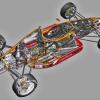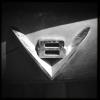I'm collecting info about the various horsepower rating systems that were in effect mainly between the two World Wars. So far I have:
United Kingdom
"RAC Rating", developed around 1904/6, tax formula from 1910-01-01 to 1947-12-12:
HP = N * B * B / 2.5
where N is number of cylinders and B bore in inches.
United States of America
"SAE Rating" - the same as "RAC Rating"????
Germany
"Steuer-PS" formula from 1906-06-03 to 1928-04-01:
PS = 12 * C / p (4-stroke engines)
PS = 18 * C / p (2-stroke engines)
where C is engine capacity in litres and p the ratio of the circumference of a circle to its diameter (~ 3.1416).
France
"Puissance fiscale" formula - I have found several formulae for postwar years (1957-77, 1978-97 and 1998-?), but nothing definite for earlier periods. The best I can come up with so far is this, which appears to have been the formula for approx. 1926-56:
CV = 18 * C / 3.15
where C is, again, engine capacity in litres and 3.15, apparently, a rounded figure for p.
Also, it seems, the result was rounded up or down to the next full figure, unlike in Germany where the result of the formula was always rounded up ("You have 4.01 PS? Sorry chap, you pay for 5!")
Before 1926, I have found references to changes in the formula for January 1913, September 1923 and around 1925, but I haven't yet figured out what they were. There also seems to have been an extra formula for OHV engines, at least in some years.
Italy
"Cavalli fiscali" formula - not much here, either. I assume that in the mid-twenties the formula was something like:
CV = 24 * C / p
where C is engine capacity in litres and p the ratio of the circumference of a circle to its diameter (~ 3.1416).
Spain
????
Can anyone expand on this?
















